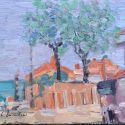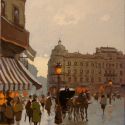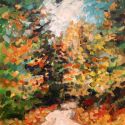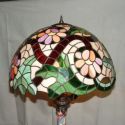There are many beautiful churches in Bucharest, many of them old and filled with stories and legends. Some of the oldest and most beautiful churches were destroyed during the Communist regime, yet among those who survived those years of hardship, some are architectural and artistic wonders. One such such is St Ilie Gorgani Church, near the center of Bucharest, between Cismigiu and the Dambovita, and this place of worship has often played a major part in the city's history.
The building was finished in November 1819, as the old records of the church show, during the reign of Gheorghie Caragea, with the help of several Orthodox bielievers, some of them being hign ranked officials. A text, carved in stone and telling all these in detail can be found at the entrance. According to other researchers, previously there was a small wooden church on the very spot, built in the 17th century and called "a Gorganului" ("gorgan" meant a small hill in those times, hence the name, but also the small rising of earth above a tomb). While we do not know who built this wooden church, we first find a mention of it in a document from 1639. In 1694, during the times of Constantin Brancoveanu, the old church also received from him an impressive bell.
Others say that the archaeological diggins made here prove that the old church was at leas partially made out of bricks, as well as the remains of (possibly) believers or officials, which sugests that there also was a small graveyard here. How old was this graveyard, was it there before the church, who was burried there, as many questions without answers. According to the text that is presented at the front of the church, the new one was built in the times of Ioan Caragea Voevod, with the help of Manolache Hrisoscoleo and his wife, Elena, alongside Radu Voinescu, Stefan Voinescu and Gheorghe Artino, as well as several merchants. All these mentioned were rich and powerfull officials, but also supporters of the Orthodox Church, and it seemed only natural for them to help buildings a new place of worship. Nicolae Iorga, one of the most important Romanian historians, once wrote that the name Gorgani doesn't come from the hill, but from one Gorgan Spataru, who was related to Matei-Voda.
Whatever the truth might be, the St Ilie Gorgani Church didn't have an easy history so far. In 1838 this beautiful - and then very impressive church - was badly damaged in an earthquake. In 1880, 1886 and 1901 serious repairs were made here, to stop the inevitable degradation of the building. The Gorgani Church has an unusual architecture, the tower of the building being in a different position that is customary. This belltower was build at the middle of the 20th century, precisely in 1935. There are two bells : one larger, of Polish manufacture and another one, smaller. This tower is made out of bricks, while the other one, much smaller, is simply wood and iron.
Little is known outside of Romania - and even among those who live in Bucharest - about the role that the St Ilie Gorgani Church played in the history of the city, during the last century and especially in the interwar times. The church is also known by the name of the "Legionary Church", as it was the favourite church in Bucharest for the members of this strange nationalist, Christian and antisemitic movement. Even since 1927 this church was discovered by the members of the future Iron Guard, who attended religious service here. In the 1930's, when the headquarters of the movement were near the church, on Gutenber Street No 3 - the house of the General Zizi Cantacuzino Granicerul, protector and major figure of the Iron Guard and later of the All for the Fatherland party. The members of this unusual Romanian form of Fascism also helped the church a lot : they built the above mentioned belltower, they substantially contributed to the buildings of the marble steps and several times offered their financial help. The impressive stairs were made with the help of Alexandru Donecu, then the chief architect of Bucharest. Several key events in the history of the movement were related to the church, such as the funeral procession for Ioan Mota and Vasile Marin, two major figures of the movement, killed in the Civil War, in Spain. Due to these ties, this was a closely observed objective in the Communist years.
The last consolidation of the church was necessary after the devastating earthquake of 1977, under the guidance of architect Constantin Joja.
A beautiful church, St Ilie Gorgani is by all means an unusual project, mixing several influences from all around. One can find inside several icons - among these there is one than can make wonders for the true believers - six tombs, covered with stone and fine inscriptions, all very old, as well as an impressive plan of archways and pilons. Of great artistic value is also the interior paintings, restored in 1913 by Constantin Popescu and extended and completed by a painter called Corbu. Much later, in 1936 - 1937, Alexandru Basarab, a painter who was also an important member of the Iron Guard, repainted the church, this time with Western influences. In 1982 the old painting was once again remade, by Pavel Chichisan and then by Elisabeta Ursu. From Basarab's work only a small part remained, among these a small medalion portrait of St Eustacius.
After 1989, the church continued to remain very popular, being renovated several times, It is a very modern and welcoming church. Beyond the beauty and the peace of the religious service, here one can find a small Christian library, opened to anyone. You can borrow books - as long as you return them on time - and the number, variety and some rare editions are worth while. And it is a great initiative. Also, the church publishes it's own small magazine, once every two months, with various religious and historical articles.
Last but definetelly not least, St Ilie Gorgani Church is a modern one, as it also has it's won website gorgani.ro. So it's no wonder that this combination of history, architectural and artistic beauty, devoted and generous priests makes this church a very special one.
2007-12-04

































